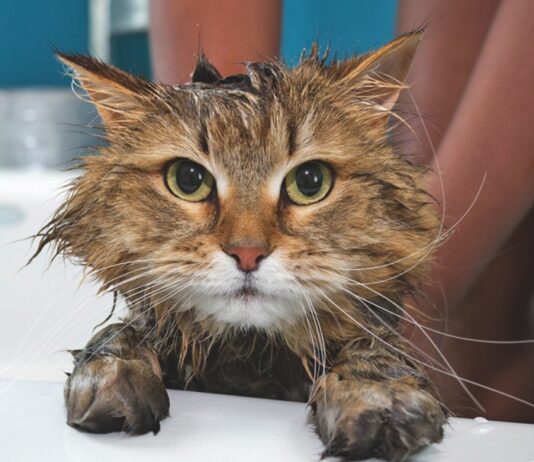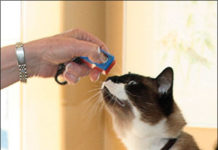Ask Elizabeth: 07/09
Thanks for responding in your February 2009 column to my question about night-time yowling. To answer your question, Decker is just 11 months old. A recent physical exam showed that he is in top form with no health problems. It was interesting to read all of the reasons why older cats may meow at night. Now Ill know what to do if Decker starts yowling at an advanced age, but in the meantime, I am hoping that we can get him to sleep through the night! I would like to take you up on your offer to expand on ways to get younger cats onto a more appropriate daytime/nighttime schedule.
Easy Entertaining For Indoor Cats
A bored cat is often an unhappy cat. Just like humans, cats need stimulation; when left on their own too long, they can experience loneliness and even depression. An unhappy cat may lose or gain weight, stop grooming itself, or become destructive. And a cat with nothing to do will often sleep the day away instead of getting needed exercise. A Daytime Babysitter. For those of us who must leave our pets alone for long hours while at work or elsewhere, the solution could be just a click away: Turn on the TV and put on a movie designed just for cats. Even a cat whos shown no interest in Brad Pitts charms or Jay Lenos jokes may lose its nonchalance when shown a movie specially produced for cats. The difference lies in the camera work. Cat videos are scaled for feline sensibilities and shot from a cats-eye-viewpoint. The camera focuses on prey just as a cat on the hunts gaze would be, with no superfluous car chases or bubbling fountains to distract attention. Because cat eyes have evolved to perceive movement more acutely than detail, cats usually find the simple moving images on screen captivating.
Helping Women and Pets
When Sarah* entered a battered womens shelter in Virginia with her three young children, she was frightened, exhausted and inconsolable. As she tried to flee her abusive husband, he had held the familys cat at knifepoint. She had to make a heart wrenching choice. "When he threatened one of my children, I had to leave [the cat]," Sarah tearfully explained to the shelter staff. "A law enforcement officer was sent to the home immediately," relates Allie Phillips, J.D., director of public policy for American Humane, in Alexandria, VA, who witnessed the event at the shelter. "[The police officer] entered the home and found the husband passed out on the floor. The officer also found the cat, who had given birth to a single kitten." When Sarah was reunited at the shelter with her kitty and newborn kitten, "She broke down crying," says Allie. "She said, Now, I have no reason to go back."
Here, Kitty, Kitty!
Theres a lighthearted saying that goes something like this: "Dogs come when called. Cats take a message and get back to you." For anyone who has ever shared their home with both canine and feline friends, you know this statement is true! But it doesnt have to be that way. "Your cat is perfectly capable of learning to come when called," says Julia D. Albright, MA, DVM, Resident in Animal Behavior at Cornell Universitys College of Veterinary Medicine. The key, Dr. Albright says, is to use a training method like "clicker training" or "target training" to reward your cat when she performs a certain task. "The clicker [an inexpensive, hand-held device that makes a distinct "clicking" sound] tells a cat what she just did is something her person liked and a treat is coming," says Dr. Albright. "For instance, if you want your cat to touch her nose with her paw, wait until she does it, then immediately "click" and give her a treat." Target training involves using your cats natural curiosity to investigate a "target" such as your finger, a pen or a spoon. When your cat engages in a desired behavior (such as touching her nose or coming up to you), "click" and give a food reward. After several trials, she will begin to associate the act with a reward. You can then begin pairing the action with a command such as "touch" or "come."
Cats and Extreme Stress
Two years ago, Alex McCarthy adopted a lively, affectionate kitten from a shelter in New York City. Alex, her cat Kit and two roommates lived harmoniously in a tiny New York apartment. Then Alex decided to move with Kit to an apartment of her own. "The day the movers came, Kit was terrified," says Alex. Once they were settled in the new apartment, Kit was never the same. She would only allow Alex to go near or touch her. When visitors came, she would run up and sniff them, then hiss. If they attempted to pet her, she would lash out at them with her paws. Sometimes, she even scratched them. Now its people who are terrified of Kit. What happened to the sweet kitten? She may be suffering from post traumatic stress disorder (PTSD), which can occur after a very stressful or frightening event - just as it can with humans.
Who Are You, Anyway?
Lets be honest: Anyone can have a bad day. Maybe the car wouldnt start. Or you forgot to set the alarm and were late for an important meeting. You might have snapped at a loved one who asked a simple question. When bombarded with an unidentified scary sound, a cat may believe that she is under attack. Perhaps your painter needed to power-wash the deck. Maybe something triggered your neighbors alarm system. Nellie, a nervous kitty, could take refuge in the closet. Or, she may instead attempt to learn the source of the scare. She will take a mental snapshot of the scene. Anything in the picture becomes suspect. Her housemate, Sue, seems a likely culprit. Frightened cats are not reasonable, and fear is a powerful trigger for aggression. Without taking time to recall that Sue has always been a friendly companion, Nellie initiates an attack. Naturally, Sue will be caught off guard. She could fight back, or will probably head for cover. As your day improves, you will probably get back on track. The victim of your ill humor - understanding that your behavior was nothing personal - will still treat you kindly. If only our cats could be as understanding. Sadly, a hiss, growl or swat from a trusted feline companion may set off a cycle of aggressive behavior that can take weeks, months or even years to resolve. Sometimes, an inciting event can clearly be identified. Often, folks come home to find that their cats seem to be at war.
Ten Ways to Go Green
It should come as no surprise that Mother Nature is on the verge of taking a permanent sick day. After all, harmful climate changes due to greenhouse gases, air and water pollution, and the destruction of natural habitats are putting our planet and its inhabitants - both two- and four-legged - in peril. Hopefully, many of us have begun to make some changes in our daily lives to help reverse the damage done to, well, everything. But what role can our cats play in being good stewards of our beleaguered planet? There are many practical ways to reduce your felines carbon pawprint, which include switching to a corn or wheat-based cat litter and recycling cat food containers instead of throwing them in the trash. Get a jump start on Earth Day (April 22) by incorporating the following tips into your daily routine. Start out slowly if you wish by trying one or two new tips each week. Encourage your friends, family members and co-workers to join in your quest for a sustainable future. Youll find that its not only fun and easy to "go green," but youll see that you can make a positive and lasting impact on our world, which will please Mother Nature.
Is it Urinary Incontinence or Urine Marking?
When a cat begins soiling the house, it is usually assumed that it is a behavioral problem or the onset of senility. However, there are several medical conditions that can cause urinary incontinence and inappropriate urination, some of which require immediate treatment. First, it is important to distinguish between incontinence and inappropriate urination. True incontinence occurs when a cat does not have voluntary control over urination; trauma, a weak primary sphincter muscle and congenital abnormalities are the most common causes of incontinence. Inappropriate urination is much more common than true incontinence; this may be a behavioral problem or it may be the result of an underlying medical condition. The most common medical cause of inappropriate urination is inflammation of the urinary bladder. While the root causes often vary significantly, the signs - called lower urinary tract signs or LUTS - are similar: frequent urination, excessive licking of the genital area and difficult or painful urination. The actual diagnosis can range from a urinary tract infection to urethral blockage. It is extremely important to seek veterinary care if your cat exhibits these signs - do not assume that the animal is simply constipated. If he is suffering from urethral blockage, he may lose consciousness and die within a day or two of complete blockage. On the other hand, it may turn out to be something as treatable as a urinary tract infection. To begin with, your veterinarian may ask several questions...
Home Sweet Home … For Your Cat
Sooner or later, most people find themselves moving to a new home. The experience can be daunting for all concerned. Amazingly enough, as long as they have their special people, most cats seem to adapt to new surroundings with no trouble at all. Still, a little prior planning can smooth the way. Lets examine some potential problem areas. It is of course both normal and desirable for a cat to explore a new environment. A bit of care must be taken so that one does not lose ones cat. Take time to block any openings that would allow a cat to reach areas that you yourself could not access should the need arise. Otherwise, you could find yourself cutting holes in sheetrock, disconnecting your home theatre or even removing plumbing fixtures to retrieve a frightened feline. In fact, if your new home is quite large, you might want to use gates or doors to initially limit the areas that your cat can access without supervision. Offer an assortment of cat-friendly mats and perches in these areas. As you offer access to more areas of the house, begin to move these familiar beds to the new locations. Do scan each new area for any toxic materials or other dangerous situations.
Ask Elizabeth: 02/09
I can certainly sympathize with your need for sleep. Decker may be keeping you awake at night due to medical or behavioral reasons. Without more background information, I dont know which is likely to be responsible in your case, so Ill discuss several possibilities in the hopes that I hit upon the cause behind Deckers insomnia. In the meantime, you should schedule an appointment with your veterinarian. May I ask Deckers age? If he is an older cat (lets say over the age of eight), several medical conditions may be involved. The first - and most common disease to consider - is hyperthyroidism, a condition in which the thyroid gland produces excess thyroid hormone leading to a myriad of problems. The classic symptoms of hyperthyroidism include unexplained weight loss and increased appetite, but some hyperthyroid cats have a decreased appetite. Other symptoms occur in some - but not all - hyperthyroid cats and may include vomiting, excessive thirst and urination, diarrhea, an unkempt haircoat and hyperactivity. Excessive thyroid hormones also have an effect on the heart, causing an increased heart rate. Some cats develop a heart murmur and others may have elevated blood pressure. Without treatment, hyperthyroidism is often fatal, so a complete physical exam and a blood test looking for increased thyroid hormone (T4) should be your first step in determining whats causing Decker to yowl at night.
Cat Play: An Essential Part of Her Care
Play is an intriguing behavior. Scientists even speculate on its function. Since all species seem to engage in play on some level, it must fulfill an important need. It might prepare youngsters for future tasks such as hunting or fighting. It certainly serves to refine communication skills between participants, and it offers an opportunity for aerobic exercise. But the main reason we play is quite simply that playing is, by definition, fun. Play is a treat that we can and should offer to our cats. Naturally we cannot engage in precisely the same games that cats play with one another. What is the best way to provide play? The first step is to establish some ground rules. No one should get hurt or be frightened. If a cat hisses, bites, or runs away, then the game should be discontinued. Another important rule is that human body parts should not be used as substitutes for toys. That is to say, a cat should not be encouraged to grab or chase hands, fingers or legs. A pony tail is not a toy. The bottom line is that cats cannot help the fact that they are predators. The drive to hunt is a powerful one, and even the most sophisticated housecat can become a skilled huntress at the sight of a tiny mouse. It is not at all uncommon for cats to stalk hands or legs or to pounce forcefully onto a long braid. Even with absence of malice, harm can be done. An ounce of prevention will serve you well. Encourage your cat to play with appropriate toys.
Neurological Disorders
Although its only the size of a golf ball, your cats brain is just about as complex and, when it comes to matters of vital concern, just about as capable as your brain. Of course, a cat uses its brain and the other components of its neurologic system to address needs and desires that are often different from yours. After all, you like to read books and watch movies; your cat likes to torment mice and play with balls of yarn. Sad to say, a cats neurologic system also resembles yours in the wide variety of serious disorders with which it can be afflicted, sometimes with fatal consequences. According to Curtis Dewey, DVM, an associate professor of neurology and neurosurgery at the Cornell University College of Veterinary Medicine, he and his colleagues typically treat four or five neurologically compromised cats each week at the universitys animal hospital.

















